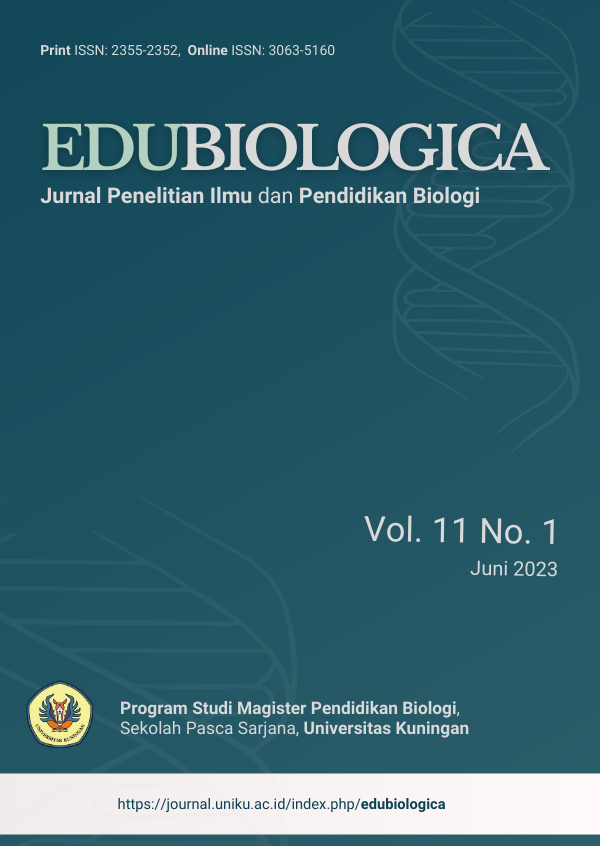Pengembangan Komik Digital Tiga Dimensi Untuk Meningkatkan Literasi Sains Dan Sikap Ilmiah Siswa
Abstract
This research and development is motivated by the limited use of digital media in the digitalization era applied by teachers in the science learning process so that scientific literacy and students' scientific attitudes are very low and student learning processes become inactive. This research and development aims to describe the products that have been developed by researchers based on the Borg and Gall (1983) model. Data collection was carried out using test, observation, feasibility questionnaires and student response questionnaires. The data analysis used is descriptive quantitative and descriptive Bio Educatio Vol. 7 No. 2 April 2022 | 2 qualitative analysis techniques. The results of the research are as follows: (1) Research and collect information. (2) Planning. (3) Development of initial product forms or research designs. (4) Preliminary field trials on subjects obtained very good categories. (5) The product revision obtained an average score based on the Likert scale, namely from a media expert with a score of 4, a material expert with a score of 4, so that it was categorized as very good and the average score of pedagogic expert 3 was categorized as good. (6) The main field trials of scientific attitude assessment based on indicators of honesty obtained 2.5 with good criteria, curiosity obtained 2.6 with good criteria, openness obtained a value of 2.1 with less criteria and distrust obtained a value of 2.1 with criteria not enough. While on feasibility obtained an average based on media aspects 3.6, language and material aspects 3.6 and benefits aspects 3.5 with good criteria and student responses obtained an average based on media aspects 3.6, language and material aspects 3, 5, the benefit aspect is 3.6 with good criteria. (7) Operational product revision is related to product revision in the fifth stage. (8) Operational field testing obtained values based on the N-gain of the experimental class at pretest 38 and posttest 87 so that there was a significant increase (9) Final product. (10) Mass deployment. Based on the research results, it can be concluded that three-dimensional digital comics can improve scientific literacy and scientific attitude of students so that they are suitable for use in schools.References
Arikunto, S. (2015). Prosedur Penelitian Suatu pendekatan Praktek. Jakarta: Rineka Cipta. hlm. 118
Chen, S. (2022). A review of image and video colorization: From analogies to deep learning. Beijing Key Laboratory of Mobile Computing and Pervasive Device. Institute of Computing Technology Chinese Academy of Sciences, Beijing, China. Preprint submitted to Journal of Visual Informatics.
Cimermanová, I. (2015). Using comics with novice EFL readers to develop reading literacy. Peer-review under responsibility of the Sakarya University.(http://creativecommons.org/licenses/by-nc-nd/4.0/)
Daryanto, (2013). Inovasi Pembelajaran Efektif. Bandung: Yrma Widya.
Hanafi. (2017). Konsep Penelitian R&D dalam Bidang Pendidikan. UIN Sultan Maulana Hasanuddin Banten. Jurnal Kajian Keislaman Volume 4 No. 2. Email: [email protected]
Handayani, T. (2021). Pengembangan Media Komik Digital Berbasis STEM dalam Meningkatkan Kemampuan Literasi Sains Siswa Sekolah Dasar. Jurnal Pembelajaran Dan Pengajaran Pendidikan Dasar. Vol. 4 No. 1, 2021 diakses dari Available online athttps://ejournal.unib.ac.id/index.php/dikdas/index pada 22 Maret 2022doi:http://dx.doi.org/10.33369/
Hidayat, A, A. 2013. Metode Penelitian Keperawatan dan Teknik Analisis Data. Jakarta : Salemba Medika
Holotescu, Carmen. (2014). Educational digital stories in 140 characters: towards a typology of micro-blog storytelling in academic courses. Jounal Procedia - Social and Behavioral Sciences 116 ( 2014 ) 4301 – 4305 diakses dari Available online at www.sciencedirect.com
Kristanto, A. (2016). Media Pembelajaran. Surabaya : Bintang Surabaya. hlm 46
Sheu, J. (2017). Mining association rules between positive word-of-mouth on social network sites and consumer acceptance: A study for derivative product of animations, comics, and games. Journal Telematics and Informatics 34 (22-23)College of Communication, National Chengchi University, No. 64, Sec. 2, ZhiNan Rd., Wenshan District, Taipei City 11605, Taiwan.
Copyright (c) 2024 Edubiologica Jurnal Penelitian Ilmu dan Pendidikan Biologi

This work is licensed under a Creative Commons Attribution-NonCommercial-ShareAlike 4.0 International License.

1.png)
_(Custom).png)
.png)

